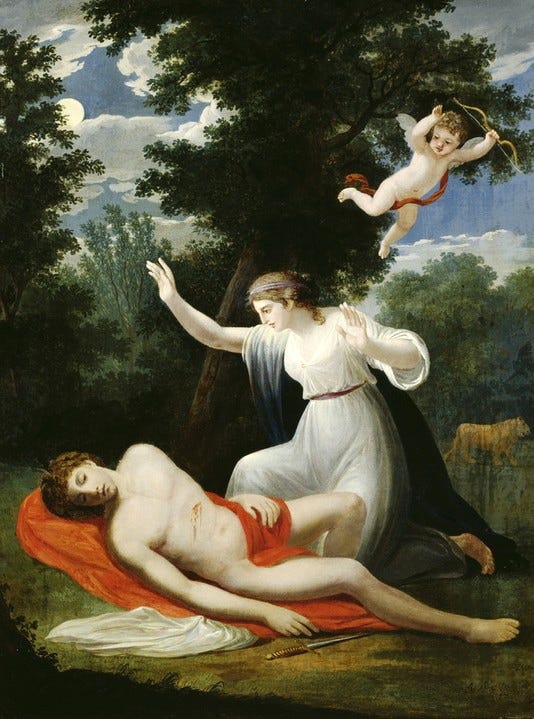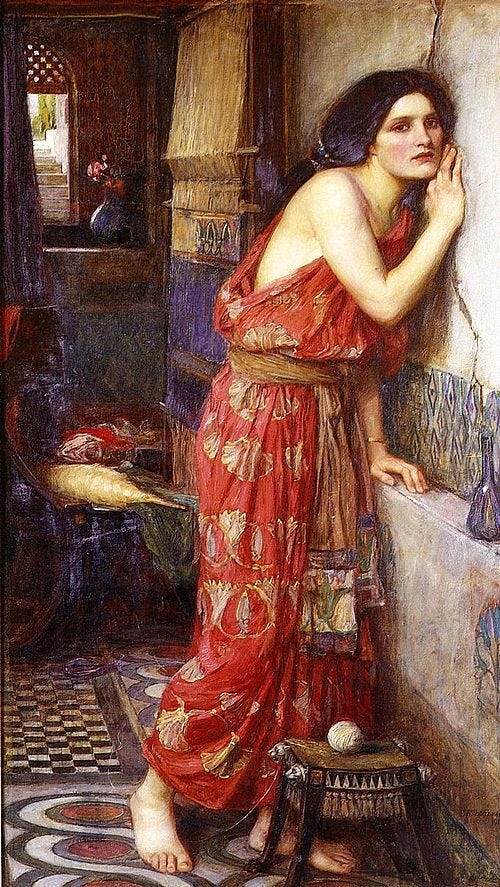The Original Romeo and Juliet
How a 2,000 Year Old Poem Shaped Western Romance
Ovid’s Pyramus and Thisbe is an archetypal story of romantic passion, love, and its ability to transcend life’s sufferings.
This story has influenced literary giants like Chaucer and Shakespeare, and even inspired the story line for Romeo and Juliet itself.
So why is this poem so influential, and why has it endured for 2,000 years?
Today we’ll look to explore just that:
Here’s Ovid’s story of Pyramus and Thisbe, and what it reveals about human nature, grief, and love’s ability to transcend human suffering.
Reminder:
I offer one on one coaching for men, focusing on faith, fitness, and the Great Books. More info here.
Additionally, if you’d like to support my mission of restoring Truth, Beauty, and Goodness to the West, subscribe below!
Two Lovers, One Wall
Part of Pyramus and Thisbe’s fascination is the story’s brevity. The ~1,000 word poem can be read in minutes, and is actually a story within a story of Ovid’s masterpiece, Metamorphoses.
In other words, this foundational poem of our Western Literary tradition was first seen as but a mere digression in a larger, more ambitious work. Despite its brevity, however, this poem’s ideas proved both brilliant and timeless.
The plot follows two young lovers in Babylon, named Pyramus and Thisbe. They’re neighbors, madly in love, but their parents forbade them from visiting each other. Ovid writes:
“But their parents could not keep them
From being in love: their nods and gestures showed it—
You know how fire suppressed burns all the fiercer.
There was a chink in the wall between the house…,
But the lovers found it—love is a finder, always—
Used it to talk through, and the loving whispers
Went back and forth in safety.”
The image is familiar: two souls in love, divided by a wall. Yet the real wall is not brick and mortar, but the feud between their families — just as in Shakespeare’s Romeo and Juliet.
Ovid suggests the chink in the wall is not just coincidence, but symbolic, as “love is a finder, always.”
This simple line touches the pulse of the narrative. Love appears as more than human emotion, but a force of fate — that which guides human beings in a providential design far beyond their own understanding.
For Pyramus and Thisbe, this destiny will be tragic, but timeless. A fate that promises misery and pain, but an immortal legacy.
The Tomb Awaits…
Pyramus and Thisbe’s love for each other grows, and they devise a plan to marry.
At night, they’ll sneak out of their parents’ house, meet at a grave called Ninus’ Tomb, and elope together.
Simple plan right? Surely, nothing could go wrong.
That night, Thisbe is first to arrive at the tomb. As she waits for Pyramus, she spots a lioness nearby with bloodied jaws. In fear, she flees, dropping her cloth, which the lioness tears to shreds and stains with blood.
Soon after, Pyramus arrives. He finds the bloodied remains of Thisbe’s cloth, and assumes that she’s has been devoured by the beast. In despair, he slays himself with his own sword. Blood gushes out, staining the whiteness of a nearby mulberry bush.
Thisbe returns moments later to find her lover gasping his last breaths. She understands what has happened, cries out, and takes her own life, lamenting:
“Death shall not keep you from me.
Wretched parents Of Pyramus and Thisbe, listen to us,
Listen to both our prayers, do not begrudge us,
Whom death has joined, lying at last together In the same tomb.”
The poem ends with both of their ashes placed in a single urn — to spend eternity together.
It’s these closing details that make this poem so brilliant. The two lovers sharing a single urn implies that their families united to honor their children’s wishes. In other words, love may have led two lovers to death, but it led two families to reconciliation.
Ovid is drawing out an important idea here:
Love doesn’t end in death, rather it directs the human soul to eternity, and in the face of such a fate, civic and petty squabbles dissolve. Love then, is the sole unifying force that brings solace and harmony to fallen man in his valley of tears.
Yet this moral is only half of Pyramus and Thisbe’s brilliance.
The full picture of Ovid’s lesson is not simply that love comforts grief, but that love can conquer it. That beneath a harsh and fallen world lies a reality ruled by undeniable beauty.
And Ovid reveals this reality in just a few short, brilliant lines…
Keep reading with a 7-day free trial
Subscribe to Sean Berube to keep reading this post and get 7 days of free access to the full post archives.




